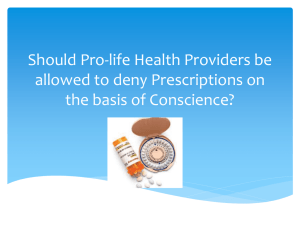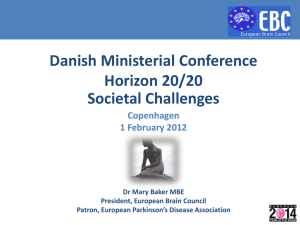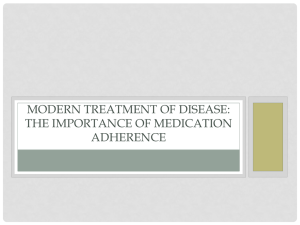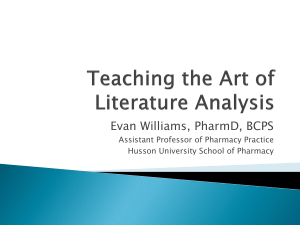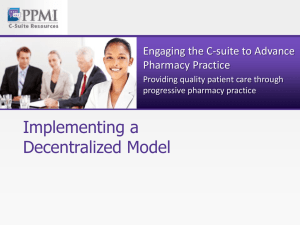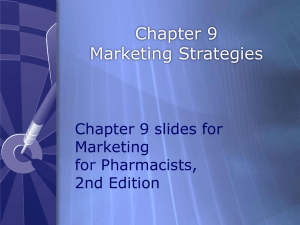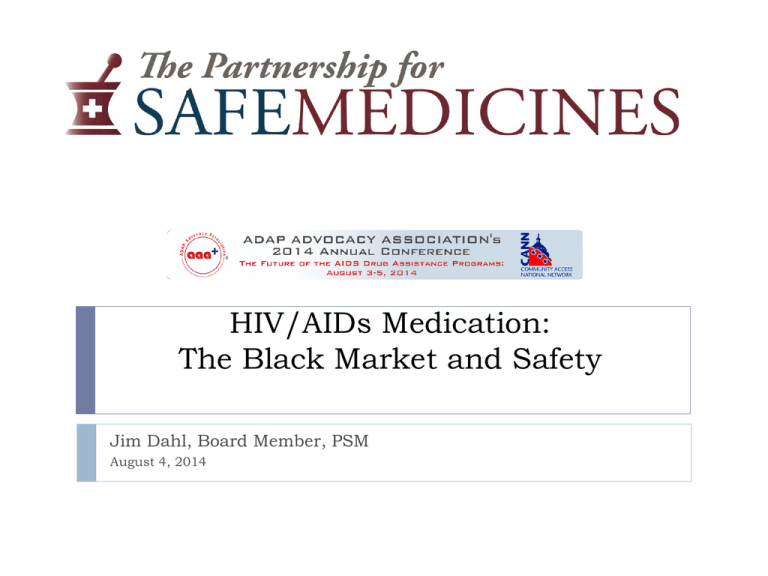
HIV/AIDs Medication:
The Black Market and Safety
Jim Dahl, Board Member, PSM
August 4, 2014
Today’s presentation
1.
2.
3.
4.
5.
6.
7.
8.
Meet the Partnership for Safe Medicines
Black market medicine in the US
Why is the black market a problem?
How the US regulates medicine
How black market drugs enter the US
How are HIV/AIDS patients being harmed?
How can we protect patients?
Where to learn more
Register for Interchange 2014: http://safedr.ug/NADDI14
PSM Members
Academy of Managed Care Pharmacy
AIDS Drug Assistance Program
Alaska Pharmacists Association
The ALS Association
American Association for Homecare
American College Health Association
American Pharmacists Association
American Society of Health System Pharmacists
Arizona Pharmacy Alliance (AzPA)
Association of Nurses in AIDS Care
BioForward
Biotechnology Industry Organization
California Healthcare Institute
California Pharmacists Association
California Society of Health-System Pharmacists
(CSHP)
Colorado Biotechnology Association
Community Access National Network
The Council for Affordable Health Insurance
European Federation of Pharmaceutical Industries
and Associations (EFPIA)
Generic Pharmaceutical Association
Global Medicines Program
Healthcare Distribution Management Association
HealthCare Institute of New Jersey
Healthcare Leadership Council
The Hispanic Institute
Illinois Pharmacists Association
Institute of Health Law Studies
Institute for Safe Medication Practices
Interamerican College of Physicians and Surgeons North Carolina Association of Pharmacists
International Anti-Counterfeiting Coalition
Oklahoma Pharmacists Association
International Federation of Pharmaceutical
Parenteral Drug Association
Manufacturers and Associations
PDMA Alliance
Kidney Cancer Association
Pennsylvania Pharmacists Association
The Latino Coalition
Pennsylvania Society of Health-system
The Life Raft Group
Pharmacists
Maryland Pharmacists Association
Pharmaceutical Industry Labor Management
Maine Pharmacists Association
Association (PILMA)
Maine Society of Health-System Pharmacists
Pharmaceutical Security Institute
(MSHP)
Pharmacists Planning Services, Inc.
Men’s Health Network
PhRMA
Missouri Pharmacy Association
RetireSafe
National Alliance for Hispanic Health
Spina Bifida Association of America
National Alliance On Mental Illness
Texas Pharmacists Association
National Association of Chain Drug Stores
Texas Society of Health-System Pharmacists
National Association for Uniformed Services
United States Chamber of Commerce
National Association of Boards of Pharmacy
University of New England College of Pharmacy
National Association of Drug Diversion
University of Texas Pharmacy School
Investigators
Vietnam Veterans of America
National Association of Manufacturers
Virginia Pharmacists Association
National Alliance of State Pharmacy Associations Vermont Pharmacists Association
National Biopharmaceutical Security Council
West Virginia Rx
National Community Pharmacists Association
WomenHeart
National Grange of the Patrons of Husbandry
International and Governmental Organizations
National Latina Health Network
World Health Organization
NeedyMeds
Nevada Board of Pharmacy
Orange County Healthcare Agency
New York State Council of Health-system
Pharmacists (NYSCHP)
Register for Interchange 2014: http://safedr.ug/NADDI14
2
Black market drugs and HIV/AIDS
Almost since there were
HIV/AIDS treatments, unlicensed
distributors have been selling
black market medications to
American pharmacies and
patients.
Since 2006 at least 86 individuals
have been charged with
distributing of black market
meds prescribed to patients with
HIV or AIDS in the US.
How common is black market medicine?
Advertising promoting the sale
of cheap prescription medicines
is ubiquitous in email and on the
internet
97% of websites selling
prescription drugs do not follow
safe practices
1 in 6 Americans buys drugs on
the internet without a
prescription
How common is black market medicine?
Why is this a problem?
Medication from unlicensed sellers is of unknown quality.
Patients taking substandard medicines risk higher viral
loads, poor health, and drug resistance, even if they are
carefully following their drug regimen.
The CDC reports that HIV surveillance sites in 2007
found that 1 in 6 newly diagnosed infections were
drug-resistant.
Black market medicines are a serious threat to the health
of current and future HIV/AIDS patients.
Why is this a problem?
Testing kits imported from countries with little or no
regulation of the pharmaceutical market may not work.
False negatives delay treatment for people who are HIV
positive and could lead to higher transmission rates.
Why is this a problem?
Drugs on the black market are not being manufactured by
companies accountable to the FDA, to state licensing
boards or anyone.
Counterfeiters claim to be selling Truvada, Sustiva, Ziagen,
and Serostim online, even without a prescription. But it’s
impossible to know whether you’re receiving safe FDAapproved medicines or drugs that are expired,
contaminated or diluted.
Why is this a problem?
Counterfeiters substitute cheap ingredients, offer
medicines in unfamiliar doses, omit instructions and safety
warnings. Sometimes the medicine a patient receives
contains harmful chemicals or contaminants. Sometimes
“medicine” contains no active ingredients at all.
Why is this a problem?
Diverters often adulterate medicine in the process of
reselling it.
In 2010, three men in New Jersey were caught relabeling
expired medication with forged labels. They removed the
old labels with lighter fluid, potentially contaminating the
expired contents.
Why is this a problem?
Addicts who resell their
medication often take a dose of
an IV drug and replace the
missing contents with water
using the same syringe. As
result, diverted medicines may
be diluted and contaminated.
Patients have contracted
hepatitis C as a result of
diverted IV drugs. Since 2004, as
many as 30,000 have been
exposed to the virus as a result
of diversion in hospital settings.
Why is this a problem?
Many drugs become
ineffective without
temperature control and
careful handling.
Norvir capsules should be
refrigerated.
Procrit, prescribed to HIV
patients with anemia, may be
damaged if the vials it comes
in are shaken.
Who knows how black
market medication has been
stored or handled?
Why is this a problem?
Undocumented
Unregulated
Unsafe
Illegal
This is not victimless crime
Patients risk their own health buying medication from
unknown sources
Buying non-FDA approved medicine supports criminals
who take advantage of people with chronic illnesses to
line their own pockets
Cut-rate diverted drugs usually come from patients who
are selling their medicines at the cost of their own health
Buying discounted prescriptions from illicit sellers creates
drug resistant strains of HIV, which makes treatment
more difficult for others
How does the US regulate medicine
distribution to keep patients safe?
The FDA regulates manufacturers of medicines
where ever the production facilities are, in the US
and beyond.
Wholesalers are regulated by the US states, each
with different rules. A voluntary cross-state
licensing program (VAWD) helps ease license
verification.
Doctors, pharmacists and pharmacies purchase
from wholesalers, and are themselves regulated by
each state.
Patients are protected by the closed, secure supply
chain. Every entity in the chain is answerable to a
regulator.
Register for Interchange 2014: http://safedr.ug/NADDI14
How a closed supply chain gets broken
Patients purchase directly from unlicensed sources, i.e. flea markets, swap
meets, non-pharmacy stores, individuals or the Internet.
Wholesalers forge documentation of legitimacy for counterfeit drugs and
pass off as authentic.
Doctors and pharmacists purchase from counterfeit drug distributors.
Stolen and partially used medications are re-sold as unused, untampered
drugs through clearinghouses back to into the legitimate supply chain.
Counterfeiters send mass quantities through customs packed in disguised
packages, i.e. speakers full of fake aspirin, that are then packaged and
distributed to pharmacies and stores looking for discounted products.
An example: Ozay Pharmaceuticals Co
In May 2011, 2 cancer patients
in Arizona had immediate bad
reactions to chemotherapy
medication administered to
them in their oncologist’s
office.
They’d been treated with
Altuzan, the Turkish version of a
cancer drug sold as Avastin in
the U.S.
The “Altuzan” they received
contained water and mold, but
none of the active ingredient
that makes Avastin effective.
An example: Ozay Pharmaceuticals Co
One source of that counterfeit medicine was Ozkan Semizoglu, the
foreign trade director of a Turkish company called Ozay
Pharmaceuticals. He sold the medicine to a British wholesaler, who
sold it to American doctors.
In 2013, Semizoglu also smuggled drugs into the U.S. directly.
Those drugs were falsely
labeled as gifts
Some of them had counterfeit
packaging and vial labeling
They were shipped at
temperatures too high to
maintain their quality
The Path of Fake Avastin
How are these products marketed?
How are these products marketed?
Rick Roberts’ health was threatened by
counterfeit medicine
In 2000, university professor Rick Roberts began
taking Serostim, a human growth hormone, to treat
weight loss and fatigue related to HIV wasting
syndrome.
Over time, he noticed stinging at the injection site
and inconsistencies in the quantities in the vials.
He learned from his pharmacist that he had been taking fake drugs.
A distributer in Nevada had purchased unapproved Serostim that included
doses of a women’s fertility drug and contaminated, diluted Serostim.
Counterfeits caused Rick 6 months of anxiety and denied him several months
of treatment. Unchecked, they could have caused permanent damage.
Black market Serostim, Nutropin AQ
Between 2000 and 2003, at least 3 different counterfeit operations
sold hundreds of boxes of diverted human growth hormone to
pharmacies who dispensed them to HIV/AIDS patients and children.
Patients who unknowingly purchased these
secondhand drugs could not rely on their
medicine to help with wasting syndrome, and
they may have been harmed by contaminants,
too.
One child—a brain cancer survivor—suffered
developmental and growth delays after he was treated
with counterfeit Nutropin AQ, another growth hormone.
Black market Serostim, Nutropin AQ
The black market drugs ultimately came from illegal sources—often from
patients re-selling their medicine or doctors selling supplies meant for
patients.
Licensed wholesalers bought questionable medicine from networks of
unlicensed distributors who covered their tracks with forged paperwork.
One group laundered more than $2.1 million
in funds from the transactions over just 2 years.
In the meantime, patients who were very ill paid
full price—more than $1,700 a week—for drugs
that were expired, diluted, damaged, contaminated,
or outright counterfeit.
Black market HIV & Hep-C testing kits
HIV and Hepatitis-C test kits help people stay healthy and protect
their partners. False positives cause tremendous stress. False
negatives mean delays in treatment and accidental transmission.
Between 2006 and 2008, residents of Louisiana, New Jersey, Ohio
and Florida unwittingly bought unapproved HIV and Hepatitis C
testing kits.
Florida resident Jonathan Barash had illegally imported the kits from
China, repackaged them and sold them as FDA approved devices.
(This is still a problem. In 2011, Canadian and British authorities warned
citizens that “illegal HIV test kits imported from China for sale online could
give an incorrect diagnosis.”)
Drug diversion of antiretrovirals
Since 2012, investigations have shown that diversion of
HIV/AIDS medicines is happening on a massive scale.
Patients have been sold secondhand, stolen and expired
medicines that have been stored in uncontrolled conditions.
There is no guarantee that these medicines are safe or
effective.
Drug diversion of antiretrovirals
Between 2008 and 2012,
customers of New York
branches of MOMS Pharmacy
were prescribed $274 million in
second hand, stolen or expired
HIV treatments.
In 2012 in New York, the FBI
seized more than 33,000 bottles
of second-hand AIDS, asthma
and schizophrenia drugs and
250,000 loose pills from drug
diverters. They were bound for
local pharmacies.
Between 2006 and 2009 a
Tennessee based company called
Cumberland Distribution sold
$58 million in HIV/AIDS,
antipsychotics and diabetes
treatments to pharmacies. Their
sources had acquired the drugs
from “street level drug
diverters.”
Selling American patients unsafe
medicine is big business
Pharmacists in the MOMS case were paid more than $27
million to sell patients unsafe drugs.
Cumberland Distribution made over $14 million in profit.
Defendants in the New York diversion case sold more that $62
million worth of second-hand prescription drugs over a 12month period.
“The ringleaders of this complex scheme not only cheated
the state Medicaid program out of millions of dollars, but
preyed on some of New York’s most vulnerable patients just
to make a quick buck.”
~ New York Attorney General Eric Schneiderman
Strategies for saving money safely
Adopt FDA
approved generics if
possible.
Generic versions of
Ziagen, Combivir,
Viramune, Retrovir,
Videx and Zerit
currently exist
More key patents are
expiring between
now and 2017
Strategies for saving money safely
Use discount cards. The NeedyMeds Drug
Discount Card can save you as much as 80%
on your prescriptions
Comparison shop using online tools
Pharmahelper.com compares prices at
VIPPS-accredited online pharmacies to find
you the best price.
WeRx.com, LowestMeds.com and GoodRX.com can
find you the lowest prices in your own neighborhood.
Strategies for saving money safely
The Partnership for Prescription Assistance (PPA)
matches patients who cannot afford medication to
prescription assistance programs. Find the program that’s
right for you for free at www.pparx.org.
How patient advocates can help
Educate people—patients and medical professionals—
about the risks of buying medication from unlicensed
distributors
Black market medicines are being sold outside the regulated drug
supply. They are often counterfeit, contaminated, diluted, improperly
stored and transported or expired.
Substandard medicines may not stop the progress of a patient’s
disease and may foster drug resistant HIV.
Since 2005, doctors and pharmacists have paid more than $13.4
million in fines in connection with buying black market drugs. Some
have also been sentenced to prison.
How patient advocates can help
Teach patients to identify illegitimate
medication at the doctor’s office:
Ask to see the packaging the drugs came
in.
Look for accurate labeling, packaging that
is in good condition, and product
descriptions in English.
Keep a record of the lot number of the
medicine
How patient advocates can help
Teach patients to identify illegitimate medication at home
Check that the packaging is clean and correctly sealed, with
instructions in English.
Compare it to past packaging. Look for differences in paper, printing,
color, and fonts. If you notice changes, do not take the drugs, and
show the packaging to your doctor.
Examine the appearance of the medicine. If it looks chipped or
cracked, or different from earlier prescriptions, it may be fake.
If unsure whether the prescription is genuine,
visit WebMD online to look up the drug's description
and appearance.
How patient advocates can help
Teach them to recognize symptoms of ineffective medicine
Pay attention to changes in the way medicine tastes.
Do not ignore side effects from a new dose of a prescription.
New reactions like a stomach ache or a head ache could signal
changes to the drug.
Note adverse effects or failure of treatment.
If you work with medical professionals, make sure that they
are alert to the possibility that patients may be using
compromised medication.
How patient advocates can help
Teach patients and medical professionals what to do if they
suspect that there is something wrong with a drug
Patients should contact the pharmacy where you
purchased the medicine
Patients and medical professionals should contact the
FDA and the manufacturer of the medication to report
your concerns.
The FDA can be contacted by calling toll-free 1-800-FDA-1088
(800-332-1088), or on the Web at www.fda.gov/medwatch.
Where can you learn more?
Pick up your copy of our report
at the conference today.
www.safemedicines.org
Thank you for the opportunity
to speak to you today.
Jim Dahl
The Partnership for Safe
Medicines
Register for Interchange 2014: http://safedr.ug/CANN2014
Register and Attend our Annual
Conference - September 18 in DC
Buy tickets and use discount code
“CANN2014” to save $100 on
registration.
http://safedr.ug/CANN2014
Sessions include:
New research about counterfeit drugs by Dr. Marv
Shepherd, University of Texas, Austin and Dr. Tim
Mackey, University of San Diego
New international developments in the fight against
counterfeit medicines
Recent prosecutions of counterfeit drug criminals in
the United States
Impacts on patient safety from counterfeit, unapproved
and diverted drugs
The real dangers and fake drugs found at fake online
pharmacies
Register for Interchange 2014: http://safedr.ug/CANN2014
Hear representatives of:
The Department of Justice
The Institute of Medicine
The Pharmaceutical Security Institute
The Office of Criminal Investigations, FDA
National Association of Drug Diversion
Investigators
The Alliance for Safe Online Pharmacies
The Federal Bureau of Investigation
The Maine Pharmacy Association
Register and Attend our Annual
Conference - September 18 in DC
September 18, 2014
Knight Conference Center
The Newseum
555 Pennsylvania Av., NW
Washington, DC
Buy tickets and use discount code “CANN2014” to save
$100 on registration.
Use this link: http://safedr.ug/CANN2014
Keynote speakers:
Mississippi Attorney General Jim Hood and
FDA Deputy Commissioner Howard Sklamberg
Register for Interchange 2014: http://safedr.ug/CANN2014

